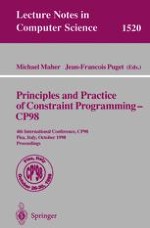Constraints have emerged as the basis of a representational and computational paradigm that draws from many disciplines and can be brought to bear on many problem domains. This volume contains papers dealing with all aspects of c- puting with constraints. In particular, there are several papers on applications of constraints, re?ecting the practical usefulness of constraint programming. The papers were presented at the 1998 International Conference on Principles and Practice of Constraint Programming (CP’98), held in Pisa, Italy, 26{30 - tober, 1998. It is the fourth in this series of conferences, following conferences in Cassis (France), Cambridge (USA), and Schloss Hagenberg (Austria). We received 115 high quality submissions. In addition, 7 abstracts submissions were not followed by a full paper, hence were not counted as submissions. The program committee selected 29 high quality papers after thorough refereeing by at least 3 experts and further discussion by committee members. We thank the referees and the program committee for the time and e ort spent in reviewing the papers. The program committee invited three speakers: { Joxan Ja ar { Peter Jeavons { Patrick Prosser Their papers are in this volume.
